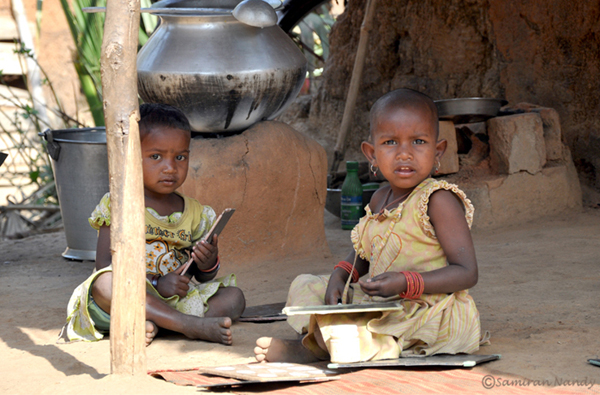How Jhawarbil's Undocumented School is Doing Its Bit For Peace And Development
KUMAR PRASHANT

If you ask the people of Kokrajhar the name of the tributary of the Sankosh river originating from Bhutan that slithers by its outskirts, they will all tell you a different name: Burasara, Jirampur, Srirampur and a dozen others. They will, however, all agree that the stream-with-a-hundred-names has seen immense violence, bloodshed and neglect. Kokrajhar is one of the four districts—along with Baksa, Chirang and Udalguri, which comprises Bodoland Territorial Council (BTC) and lies in the foothills of Bhutan. The district has seen innumerable conflicts between Bodos; Assamese; Santhalis, Munda and Oraon; and Muslims and Bangladeshi Muslims, apply all the permutations and combinations you can and you shall find a conflict between any two communities.
The riots of 1996, 1998 and 2014 between Bodos: the native tribe of Bodoland, and tribes from Santhal Paragana in Central India: Santhals, Oraon and Munda, which were either forced to move to Assam by the British to work in the tea gardens or moved here later in search for employment opportunities, killed tens of thousands of people, destroying families and communities and leaving more than a million homeless. The conflicts and particularly the fear of riots has had a deep psychological impact on the tribes and ethnicities of Bodoland and this has pushed Santhals, Oraon, Mundas into the periphery, just as Bodos have been in the greater politics of Assam. In 2010, after they were evicted from a relief camp in Sapkata in Kokrajhar and given a support of Rs 50,000 for a family, about 56,000 Santhal families had to choose between going back to their houses amongst the Bodos, or to Chotanagpur Plateau where their ancestors hail from or find their way into the forests of Assam. About 1500 such families decided to make new homes for themselves on the other side of the Burasara stream, a forested area.
They named the new village Jhawarbil—literally meaning a stream surrounded by Jhawar trees in Santhali, and managed with the little they had. Mosse Tudu, one of the thousands who was forced into the relief camp, had started a school in Sapkata believing that education is the only way to empower the community and move out of the cycle of riots. After the eviction and the exodus to Jhawarbil, a new school was set up in 2011 by the Santhals with a firm determination that education was key to a community’s development.
After much thought, the school was named Jhawarbil Suluk Gwjwn Vidyalaya. The words ‘Suluk’ in Santhali and ‘Gwjwn’ in Boro—the language of the Bodos, mean peace, symbolising peace between the two warring communities. Sakariya Kisku, 27, and the headmaster of the school informs that though no Bodo students study in the school, the school is open to them and the Santhali community has decided to reserve seats for Bodo students, should they ever want to study in the village school, and so is the provision for Bodo teachers.The school is mostly a kutcha structure made of jute sticks and asbestos and there are seven rooms for classes Nursery to VII. On some blackboards, you may find students learning how to measure the temperature of hot water, and while passing by some other lower class, you may hear students reciting rhymes at the top of their voice. The school has seven teachers, most of who are students in college pursuing their Bachelors through correspondence earning a meagre slurry of Rs 3000 per month.
The school does much more than just teaching. Ms Rani Hembrom tells us that the school is a hotbed of activities that help the village community in a multitude of ways: “We have mental health camps with the help of a local NGO Nerswn and we regularly conduct guardian-teacher meets which are used as an opportunity to teach people about the ills of the society and ways to protect themselves during riots.” The school has fostered a sense of community amongst the eight hamlets of Jhawarbil who come together to help strengthen the school in various ways, be it the construction of toilets or a well or a staff room.
The region sees massive child trafficking rates and programmes are held to aware parents and children about child rights and child trafficking. Sakla, a twelve-year-old boy was trafficked to Bhutan to work for a family after someone convinced his parents of providing for their son’s education. Today, after he has been brought back with the help of local people, he studies in Standard IV and hopes to study at a university some day.
However, you will not find the word Jhawarbil in the records of the government, much less the Suluk Gwjwn Vidyalaya. The area is an encroached land and for the past seven years, the Santhals are struggling to register their lands and the school so it could get supplies from the government. Without mid-day meals, books, uniforms, well-paid teachers and staff, and a proper building, the school is struggling with the expenses. The villagers and the NGO continue to help the school with some funds, but clearly not enough. “We have problems but we have achieved a lot. All 323 children in Jhawarbil come to school and drop-out rates are zero. How many villages in India can boast of that?,” Rani boasts.



